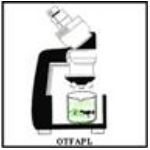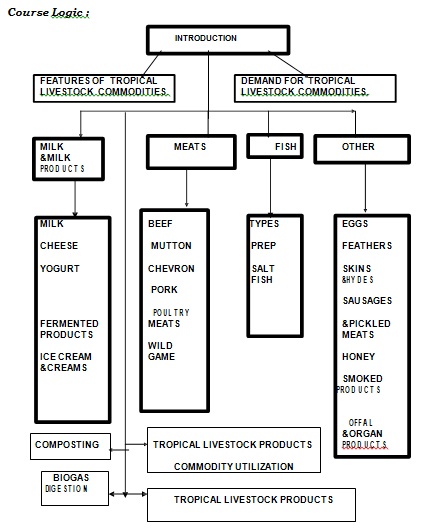
AGLS 2004 - Livestock Products Technology
1.1 Course objectives
1.1.1. To highlight the elements of the tropics which must be managed for efficient extraction, harvesting and use of animal products by mankind
1.1.2. To outline the principles and methods used in the processing of livestock products for use in the developing tropics.
back to top
1.2 Learning Objectives
At the end of this course students should be able to do the following:
1.2.1. to list the elements of the Tropics that must be managed for efficient extraction, harvesting and use of animal products by mankind;

1.2.2. to list the composition of milk and milk products;
1.2.3. to list and describe the different fermentation processes in milk;
1.2.4. to list and describe the different types of milk products and the essential steps in their manufacture;
1.2.5. to list some of the approaches to the grading and pricing of milk and to explain the reasons behind each approach;
1.2.6. to list and briefly describe the different approaches to preserving all forms of meats;
1.2.7. to list and describe the different approaches used in describing cuts of beef;
1.2.8. to list and describe the different approaches to grading meats;
1.2.9. to describe the process of ageing of meats;
1.2.10. to list and describe the different approaches to making leather and preserving animal skins;
1.2.11. to know what opportunities exist for the efficient use of animal parts conventionally known as wastes;
1.2.12. to list and characterize the meats from poultry, pigs, fish, cattle, sheep, goats, and wild game;
1.2.13. to know the technology and processes behind the handling and marketing of eggs;
1.2.14. to list and describe spoilage in fish;
1.2.15. to list and describe the different methods of improving the palatability of beef;
1.2.16. to list and describe the factors affecting the demand for livestock products;
1.2.17. to know the composition of honey, harvesting honey, uses of honey, packaging and marketing of honey, grading of honey.
back to top
1.3 Course Logic
This course is ideally taught in chronological order according to the below flowchart.
 back to top
back to top
(yellowdiv)
Course Outline
Outline of Course Modules and Units
-
-
- 1.1.1 Overview of Livestock Production Systems in CARICOM region
- 1.1.2 Importance of ruminants to our economies and to mankind
- 1.1.3 Non-Ruminant Livestock Production
- 1.1.4 The linkage between the production of food from livestock and crop
- 1.1.5 Factors Affecting Livestock Production
- 1.1.6 Types of Livestock Production Systems
-
- 1.2.1 The Tropics Defined
- 1.2.2 The Diversity of the Tropical Environment
- 1.2.3 Climatic factors of prime importance to agriculture and animal production in the Tropics
- 1.2.4 Physical factors of prime importance to agriculture and animal production in the Tropics
- 1.2.5 Some socio-economic considerations of relevance to the Tropics
- 1.2.6 Animal Production in the Tropics: Status and Horizons
- 1.2.7 Features of Tropical Livestock Commodities
-
In this section, we cover:
1.1 Course objectives - what this course is about and how it contributes to livestock production on a global and regional basis
1.2 Learning objectives - what you should have learnt at the end of the course
1.3 Course logic - the way in which the various modules and units link together. Ideally, the chronological order in which material should be taught
1.1 Course objectives - what this course is about and how it contributes to livestock production on a global and regional basis
1.2 Learning objectives - what you should have learnt at the end of the course
1.3 Course logic - the way in which the various modules and units link together. Ideally, the chronological order in which material should be taught
This course covers the technology of milk, meat, meat products and eggs; including quality, consumer demand, methods of storage, distribution and processing, preparation and market presentation. Skin preservation, processing and grading will also be explored in addition to various farms and sites during field visits.
1.1 Course objectives
1.1.1. To highlight the elements of the tropics which must be managed for efficient extraction, harvesting and use of animal products by mankind
1.1.2. To outline the principles and methods used in the processing of livestock products for use in the developing tropics.
back to top
1.2 Learning Objectives
At the end of this course students should be able to do the following:
1.2.1. to list the elements of the Tropics that must be managed for efficient extraction, harvesting and use of animal products by mankind;

1.2.2. to list the composition of milk and milk products;
1.2.3. to list and describe the different fermentation processes in milk;
1.2.4. to list and describe the different types of milk products and the essential steps in their manufacture;
1.2.5. to list some of the approaches to the grading and pricing of milk and to explain the reasons behind each approach;
1.2.6. to list and briefly describe the different approaches to preserving all forms of meats;
1.2.7. to list and describe the different approaches used in describing cuts of beef;
1.2.8. to list and describe the different approaches to grading meats;
1.2.9. to describe the process of ageing of meats;
1.2.10. to list and describe the different approaches to making leather and preserving animal skins;
1.2.11. to know what opportunities exist for the efficient use of animal parts conventionally known as wastes;
1.2.12. to list and characterize the meats from poultry, pigs, fish, cattle, sheep, goats, and wild game;
1.2.13. to know the technology and processes behind the handling and marketing of eggs;
1.2.14. to list and describe spoilage in fish;
1.2.15. to list and describe the different methods of improving the palatability of beef;
1.2.16. to list and describe the factors affecting the demand for livestock products;
1.2.17. to know the composition of honey, harvesting honey, uses of honey, packaging and marketing of honey, grading of honey.
back to top
1.3 Course Logic
This course is ideally taught in chronological order according to the below flowchart.
